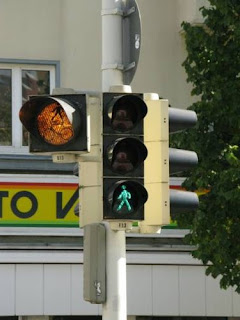I've actually caught myself wondering why traffic lights are the way that they are. Why Red-Yellow-Green? Do other countries use the same colors? So I jumped at the opportunity to do a little research on the subject and get credit for it. Speaking of traffic lights, I have a typical US example here:
Red on top, yellow in the center, and green on the bottom. This order is the same everywhere in the world from the information I could gather. However, not all lights are aligned vertically like this. As you may have seen around the country, some are horizontal instead. The one on top is from Canada, where vertical lights are common, while the one on the bottom is from Japan, where it is the norm to orient the lights horizontally.
While interviewing people around the world, I was at first surprised how alike traffic signals were. Even in Japan, the basics are the same. However, interviewing a friend in England, I was taken aback when he described the light sequence as "Red, Red-Amber, Green, Amber, and Red again." An interview with a German friend turned up the same thing. Sure enough, the Red-Amber light is a European phenomenon. They described it as a "get ready to go" light, but it lasts only a second, just enough time to take your foot off the brake pedal. To confirm it wasn't something spread by the British Empire, I asked my friend Lee from New Zealand if they used this combination, and they did not, it is confined to Europe. The first picture was sent by my friend in England, the second is from Germany.
By now another oddity was catching my attention. The British traffic light was attached to a pole at the side of the road, where in the US we might set up a stop sign. I asked if this was typical in the United Kingdom and was told that it was. I began to ask around my contacts about this and it seemed universal: In England, in Germany, in Chile, in Japan, and in New Zealand, traffic lights were posted beside the road, or attached to a pole which extended over the road. Never did I hear an account of lights being suspended over the intersection by wire, which is somewhat universal in the United States. The next two photos show overhead lights from Germany and Japan, both mounted by poles over their respective intersections:
Of course, not all traffic lights are directed at cars. The United States is a very car-centric society, but elsewhere traffic lights are used for all sorts of traffic. I have two German examples, the first used for a bike path crossing a street. The second shows a more typical pedestrian crossing, with a flashing yellow light to warn oncoming traffic that the crosswalk is is use. The third example is a pedestrian light from Japan, which shows a visual countdown.
Now that we've taken a quick tour around the world to look at their lights, let's turn our eyes to the future of the traffic light. Although the position of the colors on the traffic light are standardized, the colors all look the same for people with red-green color blindness. One solution for this comes in the form of changing the shapes of each light, so it doesn't rely on color alone. To paraphrase the movie Starman, "Square means go, Triangle means stop, Circle means go really really fast."
Another innovation in the design of the traffic light is the addition of a progress bar so commuters can tell how long a red light will stay red. The idea behind this design is that drivers can turn off their car at a red light to conserve gas and cut down on emissions while knowing how much time they have to do this. Personally, I don't think this is a good idea, since I've heard turning on a car burns a whole minute's worth of gasoline, and most lights don't last that long... but I do appreciate the idea of a progress bar.
Other changes are much more mundane and are already ongoing. For example, you may have noticed in recent years that traffic lights have been receiving a face lift. Incandescent bulbs in signals are being replaced by LED displays, reducing power requirements. Considering that traffic lights are constantly active and how many lights are in any given city, the savings add up quickly.
Also becoming more prevalent is the use of programed lights. Whereas lights used to be operated manually, and then predominately on timers, traffic lights can now my synchronized along a roadway so that, in theory, traffic should be able to pass through and hit all green lights. I've had limited success with this so far, and sometimes it seems I hit all red lights, but technology will catch up one day.












1 comment:
Fascinating! I'm still wondering what the pole- vs. wire-suspension tells us, but I suspect it tells us something important about different notions of public (tax-supported) investment in the public environment. Like you, I'm skeptical of the progress bar sales job--turn off your car!--but I wonder if it has to do with other cultural changes. Does the progress bar head off road rage? Are we so used to constant updates of information--like online newspapers updated every few minutes vs. the old-fashioned daily--that we NEED this kind of information. Or does it just serve the purpose of the European yellow light?
Post a Comment